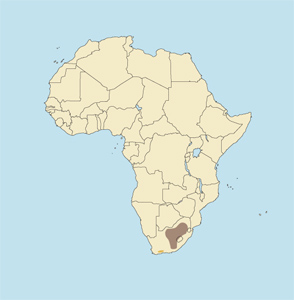 |
 |
Damaliscus dorcas dorcas
Bontebok (Sp), Buntbock (G), Bontebok (F), Bontebok (Af). The name "bontebok" was bestowed by early Dutch settlers near the Cape of Good Hope in allusion to the animal's many-colored coat.
DESCRIPTION Shoulder height 39-40 inches (99-102 cm). Weight 160-180 pounds (72-82 kg).
The bontebok is a medium-sized antelope, similar in shape to the tsessebe and topi, but smaller and with the back much less sloping. It is a handsome, strikingly patterned, richly colored animal. The overall color is a rich dark brown with an iridescent purplish sheen, turning silvery fawn on the shoulders and back. There is a conspicuous white facial blaze from the base of the horns to the nose-usually unbroken, but sometimes divided by a narrow brown band. The large white rump patch extends above the base of the tail. The belly, the lower legs to above the knees, and the upper part of the tail are white. The horns (both sexes) are rather small, heavily ringed and lyrate. They are black in color, with the rings rather widely spaced and completely encircling the horns. Females are similar, but smaller, and have thinner horns.
BEHAVIOR Gregarious, it lives in small herds. Exclusively a grazer. Drinks water daily. Eyesight and hearing are very good, sense of smell is good. Extraordinarily unwary.
HABITAT Open grassland.
DISTRIBUTION Within recent centuries, the bontebok had a narrow range in southwestern Cape Province in South Africa, from Bot River to Mossel Bay on the coast, and inland to the Sondereind and Langeberg mountains. Today, it is found only in Bontebok National Park near Swellendam, and on a number of private ranches in South Africa where it has been introduced. Nearly all of these introductions have been outside the bontebok's natural historic range.
REMARKS These days, bonteboks are found only within fenced pastures, and the harvest is restricted to surplus males. Both a landowner certificate and an export permit from provincial authorities are required for export from South Africa (and for importation in the United States). Unfortunately, from the sportsman's point of view, the bontbok is collected rather than hunted, because-through some odd quirk of nature-it has never learned to be wary. But one should not abstain from taking one on this account, because if it were not for the trophy fees, few landowners would go to the expense and trouble of keeping and protecting bonteboks, and their numbers would diminish. By harvesting surplus males, sportsmen are helping to conserve and protect this rare subspecies.
PLEASE NOTE Some farmers have crossed bonteboks with blesboks, thereby creating hybrids that exhibit a variety of characteristics. There probably is nothing inherently wrong with this, because-if crossing and backcrossing is done conscientiously and enough times-the product should be indistinguishable from the original pure bontebok. But, unfortunately, some breeders have sold as "bonteboks" hybrids that are a generation or two shy of purebred development, and some professional hunters have guided clients to them. Hunters are strongly advised to learn to distinguish a purebred bontebok from a hybrid before hunting them.
STATUS Bontebok were nearly exterminated in the early 19th century through overhunting by European settlers. They were saved by the actions of some Cape farmers-notably the Van der Byl families (in 1837) and the Van Breda and Albertyn families-who protected them on their properties. Bontebok National Park was established in 1931, and the population has increased to where the subspecies is now secure. Listed as out of danger by the IUCN and downlisted to Appendix II of CITES, but unaccountably still listed as endangered by the USF&WS.
|





